Derby's Heritage Part 27 - Railway Village
w/e 25 March 2012
All this week's pictures were taken
with a Kodak DX6490
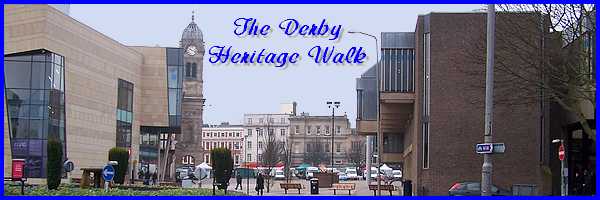
By the end of Part 26, we had reached the Derby Midland
Railway Station and in this part we will concentrate mainly on
a triangle of three streets that were built as a "railway
village" adjacent to the station.
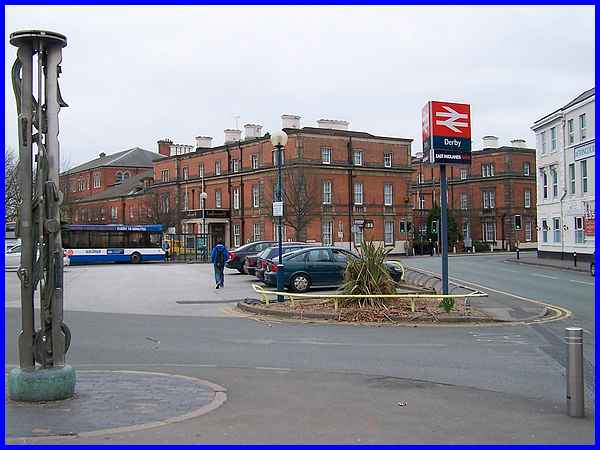
From the station entrance we can look back for another view of
the grand building that is the Midland Hotel which was opened
in 1841 for first class passengers on the railway or as it was
more genteelly put for the ‘Accommodation of the Gentry
and Nobility’, a nobility that included Queen Victoria.
|
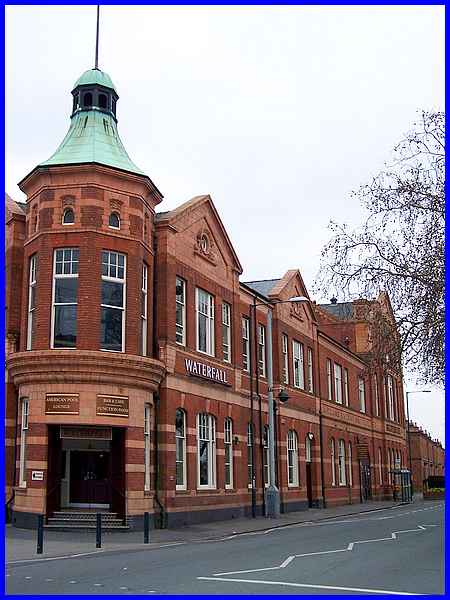
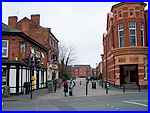 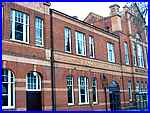 Directly opposite the railway
station is the first of the three streets. This is Midland Place
(left) and on the corner with the second of the three streets
Railway Terrace, is the former Midland Railway Institute (right
and above). Designed by the railway company's architect Charles
Trubshaw, the building with its distinctive tower and terracotta
decoration was built in 1894. Directly opposite the railway
station is the first of the three streets. This is Midland Place
(left) and on the corner with the second of the three streets
Railway Terrace, is the former Midland Railway Institute (right
and above). Designed by the railway company's architect Charles
Trubshaw, the building with its distinctive tower and terracotta
decoration was built in 1894.
|

Railway Terrace is the second of the three streets and it runs
parallel to the railway lines which are over to the right in
this view beyond the station car park. The cul-de-sac on the
left is Leeds Place which was named after one of the more northerly
destinations of the North Midland Railway. Sheffield Place, also
named after a northerly destination was on the right where the
car park is but this side of the road did not contain housing.
Old maps show large "Cheese Warehouses" here, one of
which (today called Wyvern House) can be seen in the distance
beyond the trees.
|
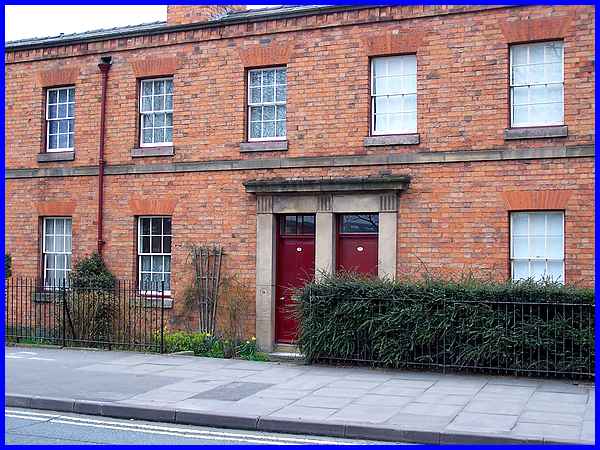
The cottages on the three streets were laid out by the North
Midland Railway Company in 1841/2 and provided housing for the
railway workers. They were designed like the Midland Hotel but
on a much more modest scale, by Francis Thompson. In 1843 Railway
Terrace was called North Midland Terrace but by 1878 it was known
as Railway Terrace and included Sheffield Place and Leeds Place
which were still included as part of Railway Terrace in 1891.
By 1880 tram lines had been laid had been laid along Railway
Terrace and these were electrified in 1904 but the system ceased
to operate in 1932.
|
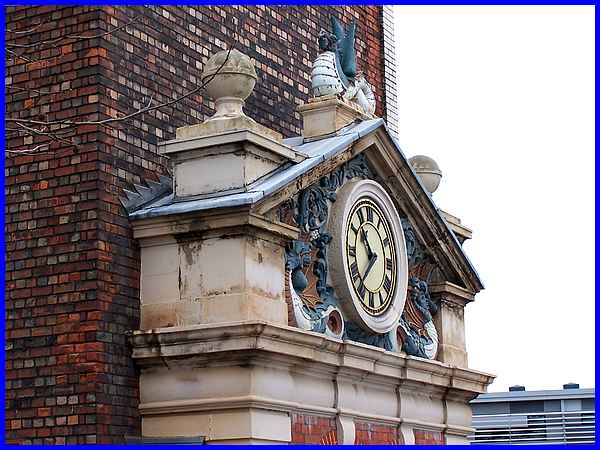
Across from the cottages on Railway Terrace is an interesting
feature in the station car park, the original clock from the
entrance to the old station. Francis Thompson, designer of the
Midland Hotel and the Railway Village was also responsible for
the original station but in the 1980s it was decided by British
Rail to replace it with a modern station.
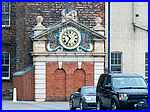 This redevelopment
of the station complex controversially necessitated the demolition
of the old one but the clock from the entrance was saved and
moved into the car park (left) where it was erected at the side
of Wyvern House. The Midland Railway had been formed in 1844
by the amalgamation of three companies, the Midland Counties
Railway, North Midland Railway and the Birmingham & Derby
Junction Railway. The crest on the Coat of Arms of the enlarged
company incorporated the Wyvern of Mercia and a wyvern (a legendary
winged reptilian creature with a dragon's head) figures above
the clock. This redevelopment
of the station complex controversially necessitated the demolition
of the old one but the clock from the entrance was saved and
moved into the car park (left) where it was erected at the side
of Wyvern House. The Midland Railway had been formed in 1844
by the amalgamation of three companies, the Midland Counties
Railway, North Midland Railway and the Birmingham & Derby
Junction Railway. The crest on the Coat of Arms of the enlarged
company incorporated the Wyvern of Mercia and a wyvern (a legendary
winged reptilian creature with a dragon's head) figures above
the clock.
|
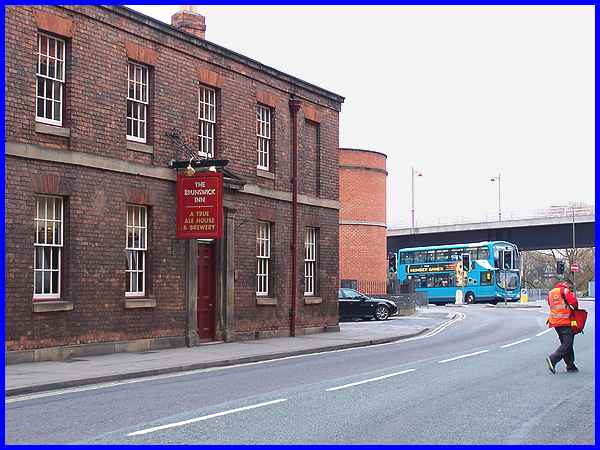
At the opposite end of Railway Terrace to the Midland Hotel is
the Brunswick Inn which was built to accommodate the railway
workers and second class passengers thus keeping them well away
from the first class travellers. The Brunswick sits at the apex
of the triangle where Calvert Street, the third street of the
triangle, forms an acute angle with Railway Terrace. More recent
brickwork on the opposite side of Calvert Street, a modern bus
and the raised Pride Parkway encapsulate over one hundred and
sixty years of history into one picture.
|
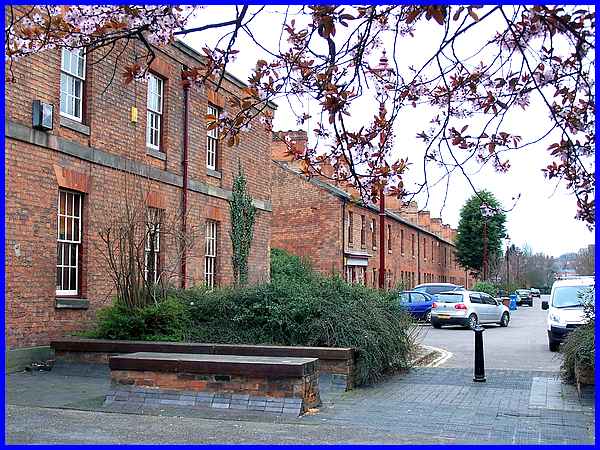
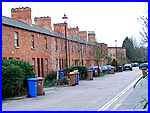 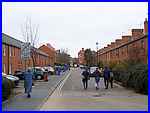 The three streets were originally named
after the NMR company - North (Street), Midland (Place) and Railway
(Terrace). As there was another North Street in Derby, it was
renamed Calvert Street in 1871, apparently after Edward Calvert
who had died in 1860 and who had been the chief cashier of Smith's
Bank in London Road and was probably responsible for the railway
company's finances. The three streets were originally named
after the NMR company - North (Street), Midland (Place) and Railway
(Terrace). As there was another North Street in Derby, it was
renamed Calvert Street in 1871, apparently after Edward Calvert
who had died in 1860 and who had been the chief cashier of Smith's
Bank in London Road and was probably responsible for the railway
company's finances.
Recent town houses built on the opposite side of Calvert Street,
add a certain symmetry to the street (above right) despite the
lack of chimney stacks but do not exude the same character as
the original cottages.
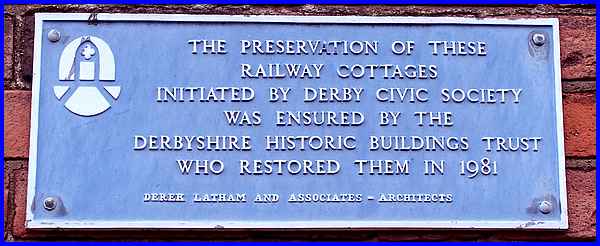
Those original cottages were restored and preserved in 1981 as
the blue plaque on the wall of one of them shows.
|

Of the ninety-two houses in the railway village development of
1841/2, fifty-five still remain. The original layout included
four shops and the rounded frontage of the cottage between Calvert
Street and Midland Place as we look back to our starting point
for this part near the station, suggests that this was a "corner"
shop in the true sense of the word.
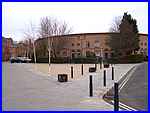 Another new development, Wellington
Crescent (left) is adjacent to Midland Place at the end of Calvert
Street. Built in the style of a railway round house it fronts
onto Wellington Street and that street dates from 1852. It Another new development, Wellington
Crescent (left) is adjacent to Midland Place at the end of Calvert
Street. Built in the style of a railway round house it fronts
onto Wellington Street and that street dates from 1852. It 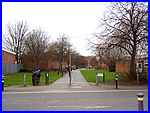 was named after Arthur Wellesley,
1st Duke of Wellington KG, who died in that year. was named after Arthur Wellesley,
1st Duke of Wellington KG, who died in that year.
Our route from here though is in the opposite direction along
the pleasant Liversage Walk (right) as we begin to head back
towards the city centre. A left turn halfway along Liversage
Walk will return us to London Road via Trinity Street which is
where we'll pick up the route in Part 28.
|

